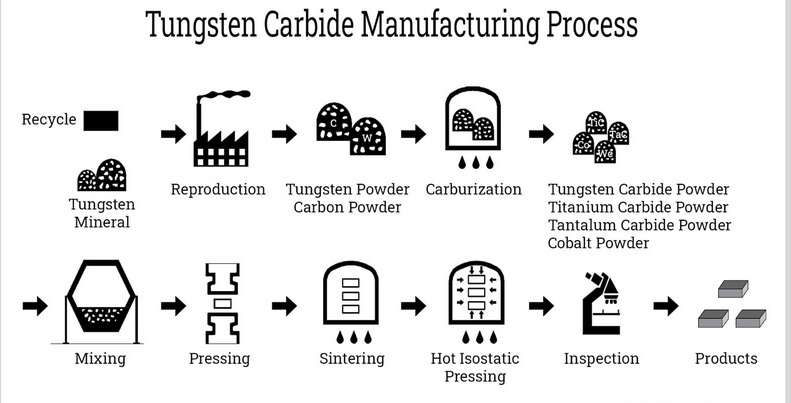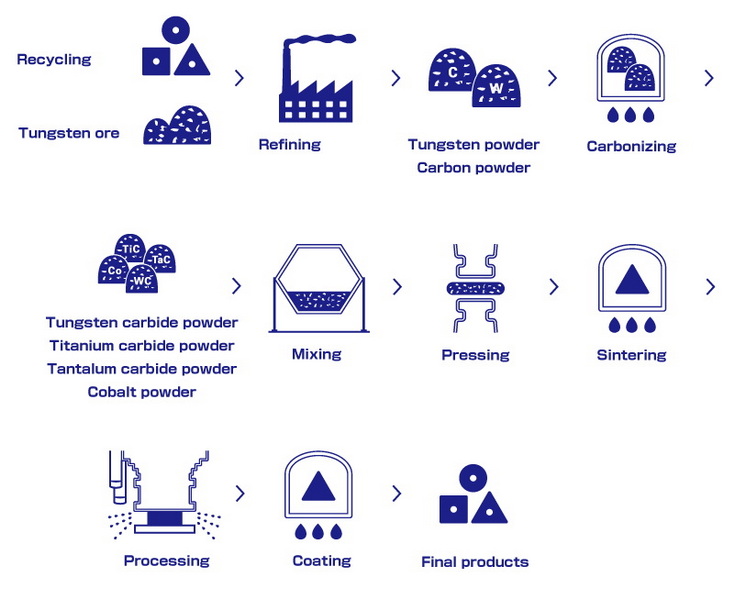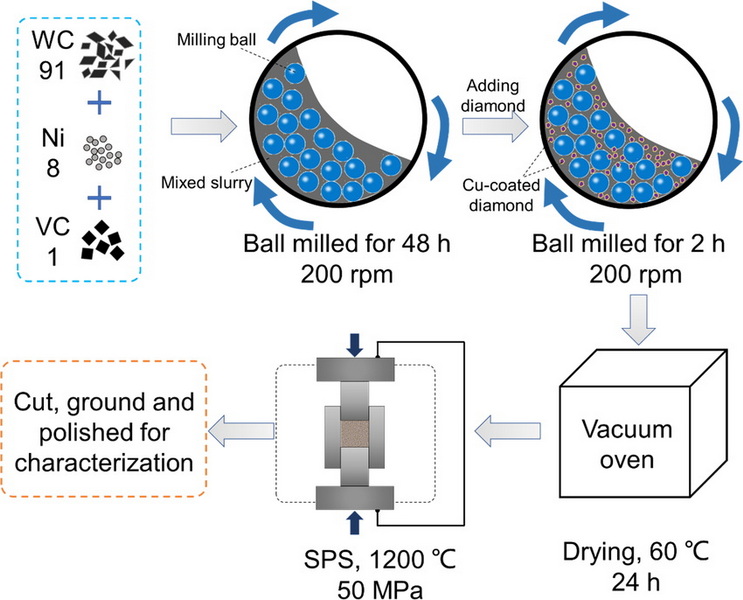Content Menu
● What is Tungsten Carbide?
● Raw Materials for Tungsten Carbide Production
● The Manufacturing Process of Tungsten Carbide
>> 1. Preparation of Tungsten Powder
>> 2. Carburization
>> 3. Mixing and Milling
>> 4. Pressing
>> 5. Sintering
>> 6. Post-Sintering Treatment
● Key Properties of Tungsten Carbide
● Applications of Tungsten Carbide
● Conclusion
● FAQ
>> 1. What makes tungsten carbide so hard?
>> 2. Can tungsten carbide be recycled?
>> 3. How does cobalt affect the properties of tungsten carbide?
>> 4. What industries use tungsten carbide?
>> 5. How does the grain size of tungsten carbide affect its performance?
● Citations:
Tungsten carbide is a remarkable compound known for its exceptional hardness and durability. It is widely used in various industries, particularly in cutting tools, mining equipment, and wear-resistant parts. Understanding how tungsten carbide is made involves exploring the raw materials, the manufacturing process, and the final applications of this versatile material.

What is Tungsten Carbide?
Tungsten carbide (WC) is a chemical compound composed of equal parts tungsten (W) and carbon (C) atoms. It appears as a fine gray powder in its basic form but can be pressed and sintered into various shapes for industrial applications. Tungsten carbide is renowned for its hardness, which is comparable to that of diamond, making it an ideal material for cutting and drilling tools.
Raw Materials for Tungsten Carbide Production
The production of tungsten carbide begins with several key raw materials:
- Tungsten Ore: The primary source of tungsten, typically extracted from minerals like wolframite or scheelite.
- Ammonium Paratungstate (APT): A purified compound derived from tungsten ore that serves as an intermediate in the production of tungsten metal.
- Tungsten Oxide: Produced by calcinating APT at high temperatures, which is then reduced to tungsten metal powder.
- Carbon Sources: Commonly soot or graphite, which are used to convert tungsten metal powder into tungsten carbide through a carburization process.
The Manufacturing Process of Tungsten Carbide
The manufacturing process of tungsten carbide involves several critical steps:
1. Preparation of Tungsten Powder
The first step in producing tungsten carbide is obtaining tungsten powder from tungsten oxide. This involves heating tungsten oxide in a hydrogen atmosphere at temperatures between 800°C and 1,000°C. The reaction reduces the oxide to pure tungsten metal.
2. Carburization
Once the tungsten powder is prepared, it undergoes a carburization process where it is mixed with carbon sources. This mixture is heated in a carbon-rich environment at high temperatures (typically between 1,400°C and 2,000°C). During this process, carbon atoms diffuse into the tungsten structure, forming tungsten carbide.
3. Mixing and Milling
After carburization, the resulting tungsten carbide powder may contain impurities or uneven particle sizes. To ensure uniformity, the powder is often mixed with a binder metal such as cobalt or nickel. This mixture is then milled using ball mills to achieve the desired particle size distribution.
4. Pressing
The blended powder is compacted into molds under high pressure to form what is known as "green" parts. This step shapes the material into its final form before sintering. The pressing process typically uses pressures ranging from 150 to 500 MPa.
5. Sintering
Sintering is a crucial step where the green parts are heated in a furnace at temperatures between 1,400°C and 1,600°C. During sintering, the binder melts and fuses the tungsten carbide grains together without melting them completely. This process enhances the density and strength of the final product.
The sintering process can be conducted in various atmospheres such as vacuum or inert gas environments to prevent oxidation.
6. Post-Sintering Treatment
After sintering, additional treatments may be performed to enhance properties such as toughness and wear resistance. This can include hot isostatic pressing (HIP), which applies pressure during heating to eliminate porosity and improve mechanical properties.

Key Properties of Tungsten Carbide
Tungsten carbide exhibits several key properties that make it highly desirable for industrial applications:
- Hardness: It ranks between 8.5 to 9 on the Mohs hardness scale, making it one of the hardest materials available.
- Wear Resistance: Its exceptional wear resistance allows tools made from tungsten carbide to maintain their sharpness longer than those made from other materials.
- Thermal Stability: Tungsten carbide can withstand high temperatures without losing its structural integrity.
- Corrosion Resistance: It exhibits good resistance to chemical corrosion, further extending its lifespan in harsh environments.
Applications of Tungsten Carbide
Due to its unique properties, tungsten carbide finds applications across various industries:
- Cutting Tools: Widely used in manufacturing drill bits, milling cutters, and saw blades due to its hardness and wear resistance.
- Mining Tools: Essential for producing drill bits and other equipment used in mining operations where durability is critical.
- Industrial Machinery: Used in components that require high wear resistance such as valves and nozzles.
- Jewelry: Increasingly popular in fashion jewelry due to its scratch resistance and aesthetic appeal.
Conclusion
In summary, tungsten carbide is produced through a meticulous process that combines raw materials like tungsten ore and carbon sources through various stages including carburization, mixing, pressing, sintering, and post-treatment processes. Its exceptional hardness and durability make it an invaluable material across multiple industries ranging from manufacturing to jewelry design.

FAQ
1. What makes tungsten carbide so hard?
Tungsten carbide's hardness comes from its unique crystal structure formed during the carburization process combined with high-temperature sintering techniques that fuse particles together without melting them completely.
2. Can tungsten carbide be recycled?
Yes, tungsten carbide can be recycled effectively by reclaiming worn-out tools or scrap material, which helps reduce waste and conserve resources.
3. How does cobalt affect the properties of tungsten carbide?
Cobalt acts as a binder in cemented carbides; varying its content alters hardness and toughness—lower cobalt content increases hardness while higher content enhances toughness but reduces hardness.
4. What industries use tungsten carbide?
Tungsten carbide is extensively used in cutting tools manufacturing, mining operations, industrial machinery components, and increasingly in jewelry making due to its aesthetic properties.
5. How does the grain size of tungsten carbide affect its performance?
The grain size influences mechanical properties; smaller grains typically provide better wear resistance while larger grains enhance impact resistance—critical for applications such as mining tools.
Citations:
[1] https://heegermaterials.com/blog/90_how-is-tungsten-carbide-made-.html
[2] https://repository.up.ac.za/bitstream/handle/2263/24896/03chapter3.pdf?sequence=4
[3] https://patents.google.com/patent/US4008090A/en
[4] https://todaysmachiningworld.com/magazine/how-it-works-making-tungsten-carbide-cutting-tools/
[5] https://www.alamy.com/stock-photo/tungsten-carbide.html
[6] https://www.linkedin.com/pulse/four-basic-stages-tungsten-carbide-sintering-process-nancy-xia
[7] https://www.retopz.com/57-frequently-asked-questions-faqs-about-tungsten-carbide/
[8] https://www.yatechmaterials.com/en/news/production-process-and-equipment-of-tungsten-carbide-powder/
[9] https://generalcarbide.com/pdf/General-Carbide-Designers-Guide-Tungsten-Carbide.pdf
[10] https://en.wikipedia.org/wiki/Tungsten_carbide
[11] https://www.bangerter.com/en/tungsten-carbide/manufacturing-process
[12] https://ceramics.org/ceramic-tech-today/tungsten-carbide-made-easy-government-industry-academia-investigate-additively-manufacturing-cemented-carbide-parts/
[13] https://www.thermalspray.com/questions-tungsten-carbide/
[14] https://todaysmachiningworld.com/magazine/how-it-works-making-tungsten-carbide-cutting-tools/
[15] https://www.hmtg.de/en/was-ist-hartmetall/bearbeitung-von-hartmetall/
[16] https://www.youtube.com/watch?v=95yS7W66-BI
[17] https://www.linkedin.com/pulse/tungstencarbide-production-process-tungsten-carbide-shijin-lei
[18] https://www.allied-material.co.jp/en/techinfo/tungsten_carbide/process.html
[19] https://ceramics.org/ceramic-tech-today/tungsten-carbide-made-easy-government-industry-academia-investigate-additively-manufacturing-cemented-carbide-parts/
[20] https://www.youtube.com/watch?v=0QrynzJ_lZ4
[21] https://www.psmindustries.com/yillik/tungsten-carbide-manufacturing-process
[22] https://www.kovametalli-in.com/manufacturing.html
[23] https://www.freepik.com/free-photos-vectors/tungsten-carbide
[24] https://www.facebook.com/KONEknives/videos/the-production-process-of-tungsten-carbide-cutter-sintering/1402030646553926/?locale=zh_CN
[25] https://www.youtube.com/watch?v=AB5by8bDPFE
[26] https://www.istockphoto.com/photos/tungsten-carbide?page=3
[27] https://www.linkedin.com/pulse/process-sintering-tungsten-carbide-zzbettercarbide
[28] https://www.everloy-cemented-carbide.com/en/process/
[29] https://www.novacarbide.com/en/Carbide-Production-Photos-1.html
[30] https://www.researchgate.net/figure/Photo-of-the-nano-crystalline-binderless-tungsten-carbide-nWC-cutting-inserts_fig1_352568741
[31] https://stock.adobe.com/search?k=tungsten+carbide
[32] http://news.chinatungsten.com/en/gold-plated-tungsten-price/46-tungsten-news-en/tungsten-information/103813-ti-13156.html
[33] https://www.researchgate.net/figure/Scanning-electron-microscopy-images-of-A-tungsten-carbide-powder-B-cobalt-powder-and-C_fig3_374723250
[34] https://www.vistametalsinc.com/tungsten-carbide-preform-process/
[35] https://www.cnczone.com/forums/metalwork-discussion/226048-quot-machine-quot-tungsten-carbide.html
[36] https://eternaltools.com/blogs/tutorials/tungsten-carbide-an-informative-guide
[37] https://consolidatedresources.com/blog/10-facts-about-tungsten-carbide/
[38] https://www.reddit.com/r/metalworking/comments/17jcjj/does_anyone_here_know_anything_about_making/
[39] http://www.carbidetechnologies.com/faqs/
[40] https://www.reddit.com/r/askscience/comments/f02z1/materials_science_question_why_does_an_extremely/
[41] https://www.researchgate.net/post/How_do_we_make_Tungsten_carbide_cutting_tool_inserts
[42] https://www.tungco.com/insights/blog/frequently-asked-questions-used-tungsten-carbide-inserts/
[43] http://machinetoolrecyclers.com/rita_hayworth.html
[44] https://tuncomfg.com/about/faq/
[45] https://www.sandvik.coromant.com/en-us/services/recycling/faq-carbide-recycling
[46] https://www.betek.de/en/products/tungsten-carbide
















